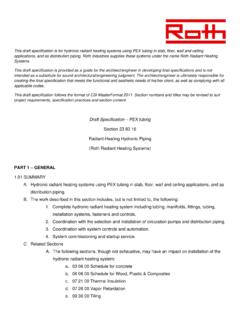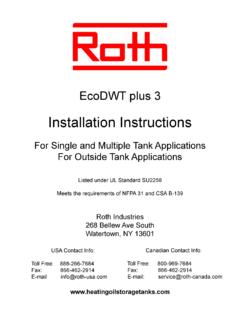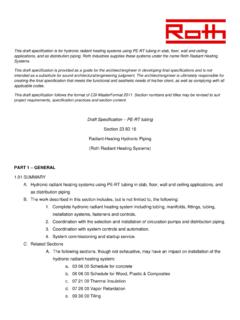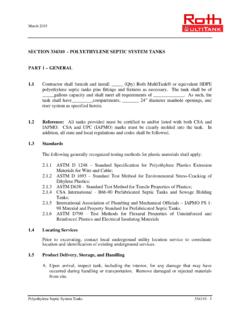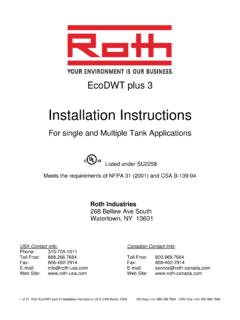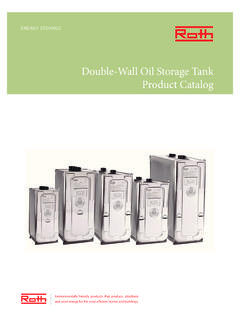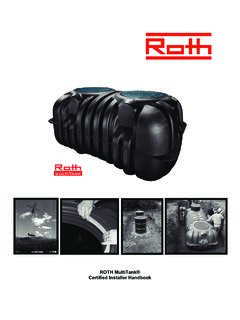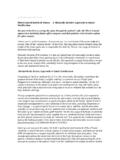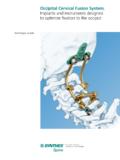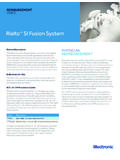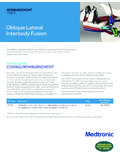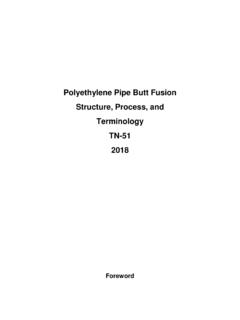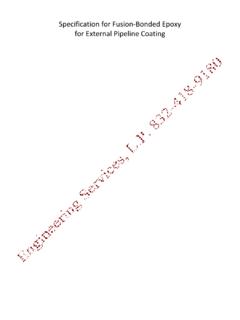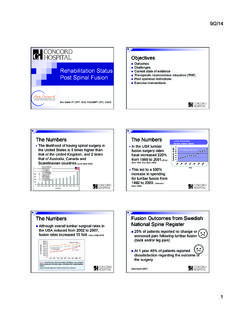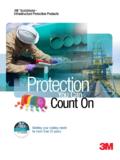Transcription of HDPE Fusion Procedures - roth-usa.com
1 Box 245 Syracuse, NY Fusion ProceduresP/N: 2300100907 Table of Contents:Section 1: OverviewAllowable Piping Materials ..3 Acceptable HDPE Pipe ..3 Section 2: SafetyOverview ..5 Considerations ..5 Extension Cords ..6 Section 3: HDPE Joining ProceduresIntroduction ..7 Thermal Heat Fusion Methods ..7 Inclement Weather ..7 Socket Fusion ..8 Butt Fusion ..11 Saddle/Conventional Fusion ..13 Electrofusion ..14 Mechanical Connections ..15 Guide Revision Table:DateByPageNoteAugust, 2010 KTAllFirst publishedHDPE Fusion ProceduresAugust, 20102 Roth Allowable Piping Materials High-density polyethylene pipe (HDPE) and cross-linked polyethylene pipe (PEX) are the only two types of piping material suitable for use in buried ground loop systems.
2 When burying HDPE or PEX pipe, mechanical fittings are not allowed with the exception of joints that are isolated from making contact with the soil (joints are heat shrink wrapped with plastic coating). Due to the inability to thermally fuse PEX, a header system in a vault or in the mechanical space is required, since mechanical fittings are necessary. For HDPE, Fusion fittings allow the installer to bury the fittings because the pipe and fittings are heated to the melting point during the Fusion process, and when cooled become one single piece of plastic. This manual will address the Fusion process for HDPE PipeThere are many types of HDPE on the market, some of which would not work well for ground loop installations.
3 For example, PE pipe used for water systems is typically designed for mechanical fittings, which requires that it be (inside diameter) controlled. This pipe would not work well for Fusion (especially socket Fusion ), since the Fusion fittings depend upon a consistent (outside diameter). HDPE must be specifically designed for heat Fusion and for ground loop applications. SDR (Standard Dimension Ratio -- the ratio of pipe outside diameter to the wall thickness) and cell classification must be selected to meet the requirements for a ground loop with durability and longevity. SDR11 is the minimum requirement to insure adequate wall thickness.
4 Cell classification is based upon the characteristics of the HDPE pipe. Approved types are PE3408, PE3608, and PE4710. Before 2005, PE3608 and PE4710 would have been considered PE3408, since they both meet stress crack resistance and hydrostatic design stress (HDS), but in fact have higher ratings than PE3408. Another material designation that is used in Europe, PE100, has created some confusion with PE4710. PE100 has a lot of different meanings for different manufacturers; the only requirement for a material to be PE100 is that it has a long-term hydrostatic strength of 10 MPa (usually referred to as a Minimum Required Strength).
5 While some PE100 resins may be excellent resins, the PE100 designation covers no other important properties of the pipe such as stress crack resistance. Roth does not recommend PE100 for ground loop installation due to the inability to validate required cell cell classification for HDPE is PE345434C or PE355434C for PE3408 pipe. Minimum cell classification for PE3608 pipe is PE345464C. Digit 7 indicates environmental stress crack resistance. The value of 3 is 192 hours; the value of 6 is greater than 2000 hours. Therefore, PE3608 meets the minimum cell classification for PE3408. The minimum cell classification for PE4710 is PE445474C, which meets the requirements for PE3408 or PE3608.
6 However, PE3408 has been used for more than 25 years in ground loop applications, and therefore PE3608 and PE4710 are not necessary unless local, state/provincial, or federal code requires the use of a pipe different than last requirement is long term stability, especially when the pipe is stored outdoors, exposed to sunlight. The last digit in the cell classification indicates the method of UV stabilization. The last digit ( PE345434C) must be C to indicate that carbon black has been added to give the pipe better UV protection. Section 1: OverviewHDPE Fusion ProceduresAugust, 2010 Roth3 Avoid pipe that is not black in color and pipe that does not have C as the UV stabilization digit in the cell with the correct ground loop piping, fittings must meet requirements for controlled pipe.
7 ASTM D2683 (Standard Specification for Socket-Type Polyethylene Fittings for Outside Diameter-Controlled Polyethylene Pipe and Tubing) and ASTM D3261 (Standard Specification for Butt Heat Fusion Polyethylene Plastic Fittings for Polyethylene Plastic Pipe and Tubing) are important designations to insure that the fittings will fuse properly to the summarize, HDPE must be controlled. HDPE must be SDR11 or better (SDR11 is recommended). HDPE must be type PE3408, PE3608, or PE4710. Do not use PE100. Minimum cell classification is PE345434C. Pipe must have UV stabilization (last digit in cell classification is C ).
8 Do not use pipe that is not black in color. Socket fittings must meet ASTM D2683; butt Fusion fittings must meet ASTM D3261. Local, state/provincial, and federal codes supersede these Fusion ProceduresAugust, 20104 Roth OverviewPipe Fusion is necessarily performed outdoors in order to join the ground loop piping in the header trench. In many cases, trenches are damp or even wet. Fusion should never be attempted in a wet trench. HDPE can produce static electricity that could be dangerous in an explosive environment. If the piping can be fused outside of the trench, and dropped into the trench, safety will be greatly improved.
9 Operators should not only read but also memorize the instruction manual for the Fusion iron and all power tools used outdoors. ConsiderationsFusion irons should always be: Plugged in and turned on only when in use. Turned off when being carried. Stored indoors away from water and excessive heat. Used only when all safety guards are in place. Stored in heat resistant cover when not in use to avoid accidental burns. Held by the insulated gripping surface to avoid electrical shock. Used with safety goggles and other safety gear as appropriate. Used with a ground-fault circuit interrupter (GFCI), either permanently installed or a plug-in type.
10 Plugged into a three-pronged outlet known to be grounded, unless they are double insulated. Used with a three-wired extension cord, if needed. Used in a dry area away from explosive fumes (gasoline or naphtha), dust or flammable materials. Fusion irons should never be: Left unattended outdoors, even when you leave temporarily. Put the tool where no curious child or unqualified adult can misuse it. Plugged in while the switch is in the on position or while being carried or moved. Carried by the cord. Used while wet or close to water. Used near sharp edges or in conditions which can damage the product, its cord or its plug.
